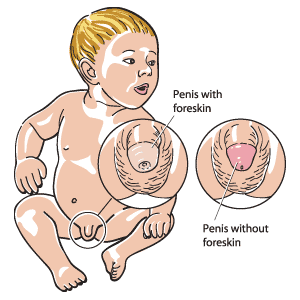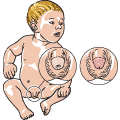Description of the procedure
The foreskin is the fold of skin that covers the end of the penis. Circumcision is a surgical procedure that removes the foreskin. It is often performed just after birth, but may also be done later in life.
When should this procedure be performed?
Circumcision is a permanent procedure. If the decision for circumcision is made, doctors typically perform this procedure on the baby shortly after birth. However, some men who were not circumcised earlier in life may consider circumcision as an adult. Before having the procedure, it is important to understand the risks and benefits.
Why is this procedure performed?
Whether or not parents decide to circumcise their baby boy is often based on many factors, including cultural, religious, personal, and medical reasons.
Some medical sources find that circumcision may:
- slightly lower the risk of getting a sexually transmitted infection (STI)
- decrease the number of urinary tract infections early in life
- decrease the risk of cancer of the penis
- prevent problems related to the narrowing of the foreskin (e.g., phimosis) and inflammation of the foreskin (e.g., balanitis)
- make cleaning the penis easier and more thorough for babies and young boys (however, learning how to clean an uncircumcised penis is not difficult and achieves the same level of personal cleanliness with just a little more attention)
Are there any risks and precautions?
Certain risks are common to all surgery and every time a local or regional anesthetic is used. These risks depend on many factors including the type of surgery and your own medical condition. The possible, but very rare, side effects include: side effects of the anesthetic, breathing problems, infection, and bleeding.
Although circumcision is generally considered safe, it does have some risk of side effects or complications. These include:
- bleeding
- infection
- pain
If you (or your child) experience these side effects or complications, contact your doctor immediately.
Rarely, the foreskin may be cut too long or too short. If this happens, another procedure to improve the appearance may be necessary. Another possible risk is damage to the penis, which may occur if there is a problem during the procedure.
If you are concerned about any symptoms following this procedure, speak to your doctor. Take the time to be sure you understand all the risks of complications and side effects as well as any precautions you or your doctor can take to avoid them. Be sure your doctor understands all your concerns.
What happens during the procedure?
- To perform the procedure, the doctor cleans the penis with an antiseptic.
- Then, an anesthetic is used to numb the area. The anesthetic may be injected into the base or skin of the penis, or an anesthetic cream may be used.
- The doctor places a clamp on the penis that pulls the foreskin away from the tip.
- The foreskin is carefully cut away.
- The penis is bandaged with gauze to prevent it from rubbing against any surfaces.
The entire procedure typically lasts for 5 to 10 minutes.
How should I prepare for this procedure?
Before having this procedure, discuss the advantages, disadvantages, long-term risks and consequences associated with the procedure with your doctor. Be sure you fully understand what will happen and are comfortable with your doctor’s answers to your questions.
Little or no preparation is needed for the procedure.
Tell your doctor or prescriber about all prescription, over-the-counter (non-prescription), and herbal medications that you (or your child) are taking. Also tell them about any medication allergies and medical conditions that you (or your child) may have. Arrange for someone to drive you (or your child) home from the hospital or clinic.
Ask your doctor or pharmacist whether you (or your child) need to stop taking any medication before the procedure.
What can I expect after the procedure?
As long as there are no complications, you (or your child) can go home immediately after the procedure. It typically takes 7 to 10 days to heal. Some bleeding in the area is normal.
Complications that need medical attention include:
- signs of infection (including fever, pus, or sores)
- swelling of the tip of the penis
- problems with the urinary tract including changes in frequency of urination
- prolonged bleeding near the tip of the penis (bleeding that continues beyond the first couple of days after the procedure)
Follow your doctor's instructions to allow the penis to heal successfully. Carefully washing and drying the penis is important to prevent infection. Apply a light coating of petroleum jelly to the end of the penis to keep it from sticking to bandages or clothing.
Results
Once the foreskin has been removed, the change is permanent.
All material copyright MediResource Inc. 1996 – 2024. Terms and conditions of use. The contents herein are for informational purposes only. Always seek the advice of your physician or other qualified health provider with any questions you may have regarding a medical condition. Source: www.medbroadcast.com/procedure/getprocedure/Circumcision


